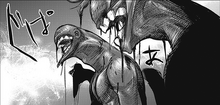
Dragon Orphans, referred to as "Bastard Children" (落とし児, Otoshi go) by Kichimura Washuu, are hostile, humanoid creatures that appeared in Tokyo after the formation of the Dragon. Spawned from the organism's massive oviducts, they are aggressive pack hunters that consume any living thing they encounter. After the Dragon's main body was destroyed, the creatures continued to reproduce and threaten both humans and ghouls in the city.
Characteristics[]
The creatures are humanoid in shape, standing larger than the average human and possessing a masculine build. Their heads are featureless with the exception of a large mouth, with human-like teeth and sharp talons for attacking their prey. Covered in a black hide, they lack any sort of external sexual characteristics or individual markings. Some posesse additionnal features like ears or eyes but most of them don't have anything other than their signature large mouths.
Two types are known to exist, with separate functions. The majority are basic drones that attack anything they encounter, with no notable traits beyond their aggression. The second type is extremely rare, and typically hides among its normal comrades. When injured or killed, this variant explodes and releases a dangerous toxin into the surrounding environment. This toxin is made up of a mass amount of RC Cells.
Victims that inhale or contact this toxin are infected, and because of the RC Cell overload in their bodies, either develop Rc cell over-secretion disease or become a ghoul.
After the destruction of the main Dragon organism, the second variant is believed to have gone extinct. Only regular drones continue to exist and hunt humans and ghouls alike.
Individuals[]
The creatures do not demonstrate any individuality, and appear to have intelligence on par with an animal or a human toddler.
In the years following their initial creation, the Peacekeepers begin to note the emergence of individual specimens that serve as dominant members of their groups.
